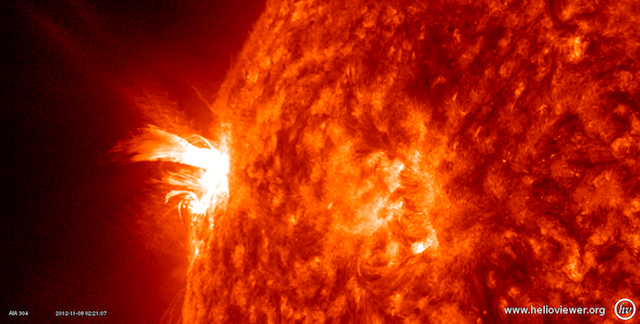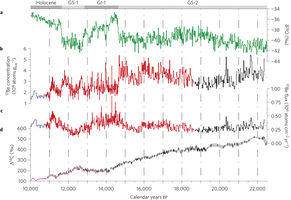'The study shows an unexpected link between solar activity and climate change,' Dr Muscheler said in a press release.
'It shows both that changes in solar activity are nothing new and that solar activity influences the climate, especially on a regional level. 'Understanding these processes helps us to better forecast the climate in certain regions.'
According to the study abstract;
http://www.nature.com/ngeo/journal/vaop/ncurrent/full/ngeo2225.html
"We find that during the Last Glacial Maximum, solar minima correlate with more negative δ18O values of ice and are accompanied by increased snow accumulation and sea-salt input over central Greenland. We suggest that solar minima could have induced changes in the stratosphere that favour the development of high-pressure blocking systems located to the south of Greenland, as has been found in observations and model simulations for recent climate9, 10. We conclude that the mechanism behind solar forcing of regional climate change may have been similar under both modern and Last Glacial Maximum climate conditions."
Dr. Muscheler emphasised that he does not believe that the sun is the main factor driving current global warming - but he does believe that climate modellers will have to pay more attention to the influence of the sun on climate change.
However, he warned that the sun was not the only factor in causing climate change.
'Climate skeptics like to say sun is causing more global warming than we think but I don't think so.
'What our paper shows is we need to include all processes - greenhouses, the sun and so on, especially for local climates which is important of course.
Persistent link between solar activity and Greenland climate during the Last Glacial Maximum
Florian Adolphi,Raimund Muscheler,Anders Svensson,Ala Aldahan,Göran Possnert,Jürg Beer,Jesper Sjolte,Svante Björck,Katja Matthes& Rémi Thiéblemont
Nature Geoscience (2014) doi:10.1038/ngeo2225Changes in solar activity have previously been proposed to cause decadal- to millennial-scale fluctuations in both the modern and Holocene climates1. Direct observational records of solar activity, such as sunspot numbers, exist for only the past few hundred years, so solar variability for earlier periods is typically reconstructed from measurements of cosmogenic radionuclides such as 10Be and 14C from ice cores and tree rings2, 3. Here we present a high-resolution 10Be record from the ice core collected from central Greenland by the Greenland Ice Core Project (GRIP). The record spans from 22,500 to 10,000 years ago, and is based on new and compiled data4, 5, 6. Using 14C records7, 8 to control for climate-related influences on 10Be deposition, we reconstruct centennial changes in solar activity. We find that during the Last Glacial Maximum, solar minima correlate with more negative δ18O values of ice and are accompanied by increased snow accumulation and sea-salt input over central Greenland. We suggest that solar minima could have induced changes in the stratosphere that favour the development of high-pressure blocking systems located to the south of Greenland, as has been found in observations and model simulations for recent climate9, 10. We conclude that the mechanism behind solar forcing of regional climate change may have been similar under both modern and Last Glacial Maximum climate conditions.Figure 1 - a, δ18O variations as recorded in the GRIP ice core21. b, 10Be concentrations from the GRIP (red: this study, black: refs 4, 5) and GISP2 (ref. 6; blue) ice cores. c, 10Be fluxes using accumulation rates inferred from the GICC05 age.





Only if one is incapable of critical thought (i.e., a non-thinking true believer in the propaganda put out by the AGW crowd) is this actually an "unexpected link".
Apparently, critical thinking was not a pre-requisite for Mr. Muscheler's PhD.